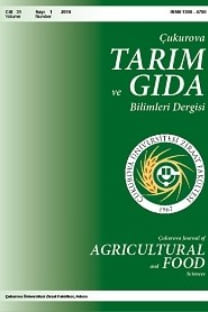Suriye’de Sığır ve Kuzu Besiciliğinde Teknik ve Ekonomik Performansın Karşılaştırılmalı Değerlendirilmesi
Bu çalışma Suriye’de geleneksel ve iyileştirilmiş besleme uygulamalarının kuzu ve sığır kuzu ve sığır performansları üzerine teknik ve ekonomik olarak etkisini değerlendirmek amacı ile yürütülmüştür. Bu amaçla, 120 erkek İvesi ve yerel ırk Frizyen melezi 12 erkek buzağı denem gruplarına ayrılmıştır. Her deneme yapılan çiftlikte iyileştirilmiş metot ile geleneksel uygulama grupları takip edilmiştir. Kuzuların besleme teknik ve ekonomik performans analiz geleneksel sistem ile iyileştirilmiş sistemin teknik ve ekonomik değerlendirmesi yapılmıştır. İyileştirilmiş beslenme programı ile geleneksel sistem arasında besi performansı, bakımından anlamlı farklılıklar (P> 0.05) tespit edilmemiştir. 1 kg canlı ağırlığın net kar kuzu ve sığır besi için sırasıyla 85 SL ve 74 SL (p
Anahtar Kelimeler:
İvesi, Frizyen, Geleneksel, Entansif, Yemleme, Performans, Suriye
Comparatıve Evaluatıon of Technıcal and Economıcal Performances in Lamb and Beef Fattenıng in Syria
This study was conducted in Syria with the aims of comparing lamb and beef production in terms of technical and economical aspects and assessing effect of improved feeding practices on lamb and beef performances. A total of 120 male Awassi lambs and 12 male Friesian calves of the local available breed (mixture of Frisian and local breeds) were assigned. Each flock (lambs and calves) was subdivided into two groups randomly to apply improved feeding and management practices to one half of the animals while the other half was fed according to the farmer’s traditional practices. The feeding technical and economic performance of lambs was significantly developed with the improved diet as compared with the traditional diet. Fattening performance of male calves did not show significant differences (P > 0.05) with the improved feeding program. Net profits of 1 kg live weight were 85 SL and 74 SL (P < 0.05) in lamb and beef fattening, respectively
Keywords:
Awassi, Frisian, Traditional, Improved, Feeding, Performance, Syria,
___
- Aaea Task Force, 2000. Commodity Costs and Returns Estimation Handbook: A Report of the AAEA Task Force on Commodity Costs and Returns. February 1, 2000, Ames, Iowa. PP 15-6.
- Abney, C.S., 2004. Feedlot performance, carcass and palatability traits, as well as subsequent economic relevance in calffed and yearling Holstein and Angus steers. M.S. Thesis, Michigan State University, Lansing, MI.
- Anuez, M., Delgado, A., Hernandez, and H., 1996. A study of concentrates and forages with ad libitum molasses urea for increasing the efficiency of growing fattening Cattle: I. Effect of the levels of concentrates. Biological Abst. 102 (5): 34.
- Arnold, R. N., Scheller, K. K., Arp, S. C., Wıllıamsz, S. N., Buege, D. R And Schaefer3, D. M., 1992. Effect of Longor Short-Term Feeding of a-Tocopheryl Acetate to Holstein and Crossbred Beif Steers on Performance, Carcass Characteristics, and Beef Color Stability. Journal of Animal Science, 70:3055-3065.
- Blaxter, K.L., And Waınman, F.W., 1966. The fasting metabolism of cattle, Brit. J. of Nutr. 20:103-110.
- CBS, 2014. Central Bank of Syria. Foreign Exchange Quotations, Archive (in Arabic).http://www.banquecentrale.gov.sy/mainar.htm. Duff, G.C., And Anderson, P.T., 2007.
- Comparative performance of Holstein vs beef breeds in the feedlot. In: Proceedings of the Southwest Nutrition and Management Conference. University of Arizona; Tucson (AZ): p. 27–36.
- Ensmınger, M.E., 1970. Sheep and Wool Science (Animal Agriculture Series). Fourth Edition. Danvill, Illinois, US. 948 PP.
- ISSN: 2636-7874
- Başlangıç: 1973
- Yayıncı: Çukurova Üniversitesi
Sayıdaki Diğer Makaleler
Serap GÖNCÜ, Murat GÖRGÜLÜ, Uğur SERBESTER
Görsel Kümelenme Eğilimi Değerlendirmesi ve R’de Uygulaması
İlyas KIRAN, Uğur SERBESTER, Ladine ÇELİK
Kuluçkalık Yumurtaların Dezenfeksiyonunda Kullanılan Doğal Ürünler
Mikail BAYLAN, Ayşen BULANCAK, Gülşen ÇOPUR AKPINAR, Sibel CANOĞULLARI
